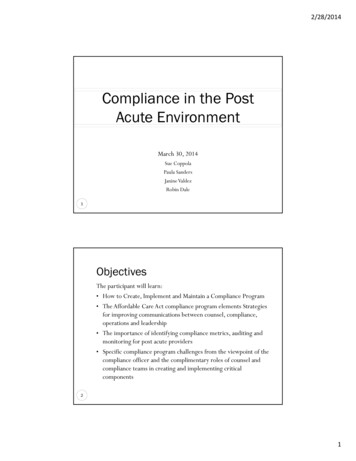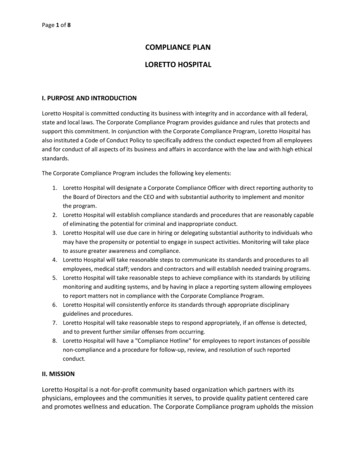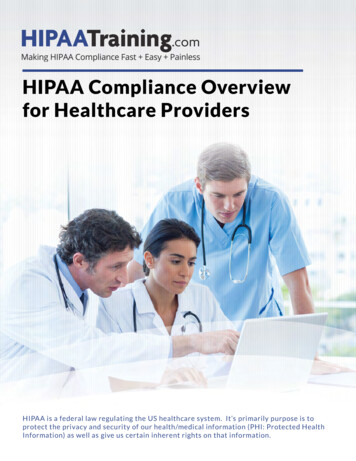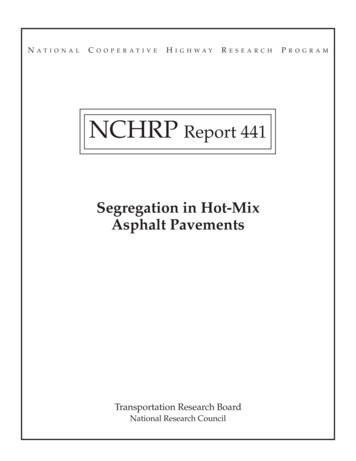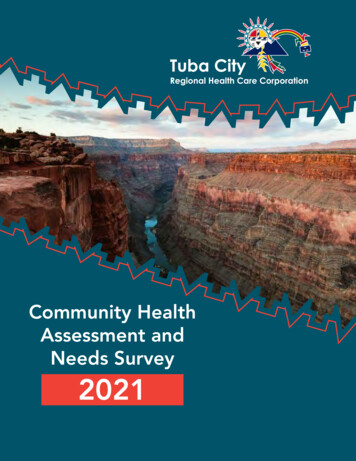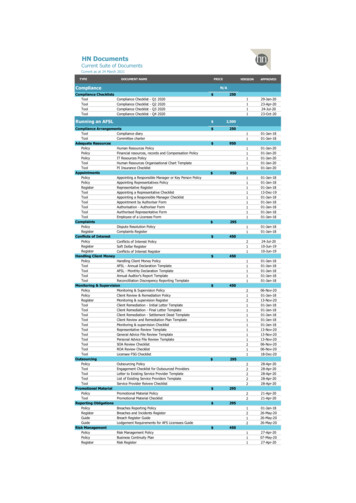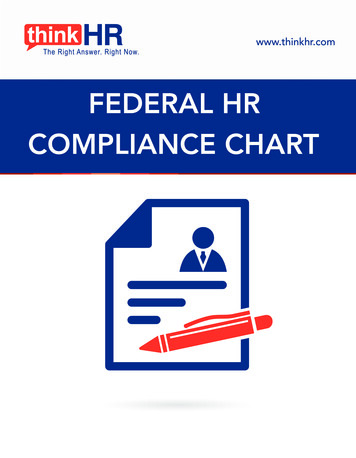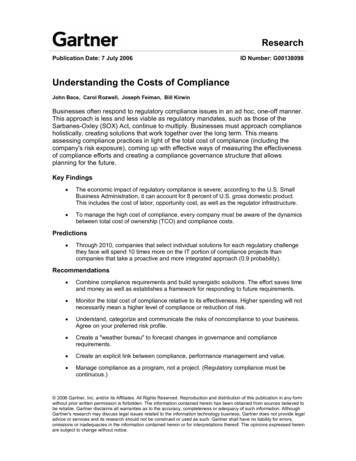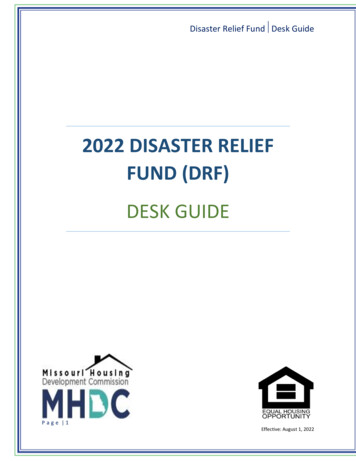
Transcription
A Compliance Officer’s Approach to Fair Market ValueAnalyses: Practical Advice and DilemmasHCCA Compliance Institute 2013National Harbor, MD April 24, 2013Lawrence W. Vernaglia Partner & Chair of the Health Care Practice Group,Foley & Lardner LLP – ModeratorRick Cameron Managing Director, Navigant ConsultingGreg Endicott Managing Director, Strategic Value Group, LLCAndrea M. Ferrari Manager, HealthCare Appraisers, Inc.Amy Kolczak Senior Associate General Counsel, University of Colorado Health
Your PanelistsLarry Vernaglia, Partner & Chair of the Health Care Practice GroupFoley & Lardner LLP Boston, MAlwv@foley.com (617) 342‐4079Greg Endicott, Managing DirectorStrategic Value Group LLC Los Angeles, CAgendicott@strategicvaluegroup.com (310) 556‐8888 Ext. 101Rick Cameron, Managing DirectorNavigant Consulting St. Louis, MOrick.cameron@navigant.com (314) 308‐4986Andrea Ferrari, ManagerHealthCare Appraisers, Inc. Delray Beach, FLaferrari@hcfmv.com (561) 330‐3488Amy Kolczak, Senior Associate General CounselUniversity of Colorado Health Fort Collins, COajk3@pvhs.org (970) 237‐7036HCCA Compliance Institute 2013A Compliance Officer’s Approach to FMV Analyses2
AgendaBackground of Fair Market ValueEngaging a valuatorTransaction elements:Physician CompensationBusiness ValuationOverall Transaction and Commercial ReasonablenessUtilizing the Valuation ReportRole of The Compliance Officer in the ValuationHCCA Compliance Institute 2013A Compliance Officer’s Approach to FMV Analyses3
FMV 101: Healthcare Arrangements& TransactionsGenerally, any transaction between potentialreferral sources must be:i. consistent with FMV; andii. commercially reasonable.A transaction can be “FMV,” but notcommercially reasonable, and vice versa.Healthcare regulations impose specific guidancethat directly impact FMV analysis:Avoid tainted market valuesAvoid improper valuation methodologiesHCCA Compliance Institute 2013A Compliance Officer’s Approach to FMV Analyses4
Transactions your organizationsmay enter where FMV plays a role1.Employment2.Recruitment and Retention Assistance3.Office Space Arrangements4.Practice acquisitions5.Call coverage6.Medical Directorships7.Management Contracts8.Joint Ventures9.Quality Integration Arrangements (clinical co‐management, P4P/P4Q models)10. Gainsharing11. Payor Contracting Strategies12. Participating Bond Transactions13. Physician Hospital Organization (PHO)14. Captive Insurance ArrangementsHCCA Compliance Institute 2013A Compliance Officer’s Approach to FMV Analyses5
General Rules of Thumb . . .“The general rule of thumb is that any remuneration flowingbetween hospitals and physicians should be at fair market valuefor actual and necessary items furnished or services renderedbased upon an arm’s‐length transaction and should not takeinto account, directly or indirectly, the value or volume of anypast or future referrals or other business generated betweenthe parties.”OIG’s Supplemental Compliance Guidance for Hospitals (January 31, 2005)HCCA Compliance Institute 2013A Compliance Officer’s Approach to FMV Analyses6
General Rules of Thumb . . .“Arrangements under which hospitals (i) providephysicians with items or services for free or less thanfair market value, (ii) relieve physicians of financialobligations they would otherwise incur, or (iii) inflatecompensation paid to physicians for items or servicespose significant risk. In such circumstances, aninference arises that the remuneration may be inexchange for generating business.”OIG’s Supplemental Compliance Guidance for Hospitals (January 31, 2005)HCCA Compliance Institute 2013A Compliance Officer’s Approach to FMV Analyses7
FMV factors into enforcementdecisions in meaningful way . . .8U.S. vs. Bradford Regional Medical Center, et al., CivilAction No. 04‐186 Erie (WD PA, Nov. 10, 2010)Payment for non‐compete from hospital to cardiology groupin connection with sublease to hospital of nuclear medicinecamera was found to violate Stark Law, notwithstandingfixed fee and independent appraisal of FMVAppraisal based on expected revenues from cardiologyreferrals in the absence of an interest in their own cardiacimaging service‐‐takes into account volume/value ofanticipated referrals from cardiology groupHCCA Compliance Institute 2013A Compliance Officer’s Approach to FMV Analyses8
What is FMV?Well, why do I care?Stark LawAntiKickback Statute (AKS)Violations may result in substantial civilmonetary penalties and/or exclusion fromparticipation in Medicare. Avoiding violationsusually requires meeting an “exception.” MostStark Law exceptions include the requirementthat payments are fair market value.Violations may result in criminal prosecution,substantial civil monetary penalties, and/orexclusion from participation in federal healthcareprograms, including Medicare; Avoidingviolations is best accomplished by meeting a“safe harbor.” Most AKS “safe harbors” includethe requirement that payments are fair marketvalue.The False Claims ActProhibits the knowing submission of false orfraudulent claims for payment to the Federalgovernment; creates mechanism for qui tamactions; violations of Stark and Antikickbackmay give rise to actions under the false claimsact.HCCA Compliance Institute 2013IRS Code for 501(c)(3) entitiesPayments in excess of fair market value mayviolate prohibition on privateinurement/excess benefit and result inintermediate sanctions and/or jeopardize taxexemption.A Compliance Officer’s Approach to FMV Analyses9
What is FMV?International Glossary of Business Valuation Terms(aka the “guidebook” for valuation professionals ‐healthcare and non‐healthcare) provides thisdefinition:FMV is the price, expressed in terms of cashequivalents, at which property would changehands between a hypothetical willing and ablebuyer and a hypothetical willing and able seller,acting at arm’s length in an open and unrestrictedmarket, when neither is under compulsion to buyor sell and when both have reasonable knowledgeof the relevant facts.HCCA Compliance Institute 2013A Compliance Officer’s Approach to FMV Analyses10
What is FMV?Stark Law provides this definition:The term “fair market value” means the value in arm’slength transactions, consistent with the general marketvalue (42 USC § 1395nn)42 CFR §411.351 – “general market value” means the pricethat an asset would bring or that would be included in aservice agreement as a result of bona fide bargainingbetween well informed parties to the agreement who arenot otherwise in a position to generate business for theother partyStark Phase I Preamble – FMV is established by a reasonablemethod that provides evidence that compensation iscomparable to that paid for comparable items or services inthe marketplace in arm’s length transactions by parties notin a position to refer to one anotherHCCA Compliance Institute 2013A Compliance Officer’s Approach to FMV Analyses11
What is FMV?AKS does not provide an explicit definition ofFMV, but many OIG publications are informativeof how the government may informally defineFMV for AKS purposes.AKS guidance suggests a similar definition ofFMV to the Stark definition – i.e., fair marketvalue is the value in arm’s length transactions,when there is no tainting by the potential of theparties to the transaction to generate referralsor other business for each other.HCCA Compliance Institute 2013A Compliance Officer’s Approach to FMV Analyses12
What is FMV?Government commentary, advisory opinions and caselaw suggest that FMV (for purposes of complying withMedicare fraud and abuse laws) is probably not:The amount that results from earnest negotiations (earnestis not necessarily “arm’s length” when there are potentialbusiness referrals in play)The amount that a specific physician “normally charges” forservicesOpportunity costWhat a physician or hospital received for similar servicesprovided to a competitor last year (unless the physician wasnot practicing nor planning a return to practice last year,such that there was no tainting of the relationship with thecompetitor by the opportunity for potential physicianreferrals)HCCA Compliance Institute 2013A Compliance Officer’s Approach to FMV Analyses13
What is FMV?Government commentary, advisory opinions andcase law suggest that FMV (for purposes ofcomplying with Medicare fraud and abuse laws)may be/probably is:A value or range of values that results from commonlyaccepted valuation principles and/or from otherwisereasonable processes and data that establish whatcompensation would be in a transaction that is similar,but in which parties are not in a position to refer orotherwise generate additional business for each otherA hypothetical concept (not necessarily what specificparties to a specific transaction think that the subjectitems or services are worth)HCCA Compliance Institute 2013A Compliance Officer’s Approach to FMV Analyses14
What is FMV?Government commentary and case law suggest that, withrespect to service agreements, FMV may be influenced by thefollowing factors:Subject matter expertise/specialty of the individual performingthe servicesEducation and training that are reasonably required to performthe services (Do the services require a neurosurgeon, or will aprimary care physician suffice?)The prevailing rate for comparable types of professionalsperforming comparable services (being mindful to avoid“tainted” values)The nature and complexity of the services providedIf the services are needed and provided in a specific geographicmarket, the unique aspects of that market such as cost of living,shortage of individuals entities that are qualified to provide theservices, etc.HCCA Compliance Institute 2013A Compliance Officer’s Approach to FMV Analyses15
Engaging a ValuatorDo you need to hire an outside valuation firm to determineFMV?The Pros of hiring an outside valuation firm:Outside valuator/valuation firm is independent thegovernment is assured that the selection and interpretationof data is not biased by the interests of stakeholdersA reputable and experienced outside valuator/valuation firmis likely to use widely accepted valuation principles defensible, reproducible resultsReputable outside valuator/valuation firm is expected to havemore extensive knowledge of valuation principles, moreexperience applying valuation principles, and better access todata than internal personnel in healthcare organizationsHCCA Compliance Institute 2013A Compliance Officer’s Approach to FMV Analyses16
Engaging a ValuatorDo you need to hire an outside valuation firm todetermine FMV?The Pros of hiring an outside valuation firm (cont.):Despite upfront cost, using an outside valuation firm cansave in the long term, especially with higher valuearrangements that are likely to attract scrutinyOutside valuator involvement may help to manage/avoidunrealistic expectations; Valuators can often spot issuesand help parties arrive at workable deal terms(particularly if engaged early in negotiations)Outside valuation firm has knowledge and expertise thatmay assist in objective evaluation of commercialreasonablenessHCCA Compliance Institute 2013A Compliance Officer’s Approach to FMV Analyses17
Engaging a ValuatorDo you need to hire an outside valuation firm to determine FMV?Experienced healthcare valuation firms will assess and orrender opinions regarding commercial reasonablenessAn important consideration because several Stark Law exceptionsrequire not only that the arrangement be FMV, but also that it be“commercially reasonable” (office space rental exception,employment exception, equipment rental exception, isolatedtransactions exception, group practice exception, indirectcompensation exception)Some argue that FMV and commercial reasonableness are sointerrelated that one cannot be determined without considerationof the otherExamples of when this would be the case:Compensation stacking scenariosSeverance obligations and/or full‐time benefits offered in part‐timeemployment arrangementsHCCA Compliance Institute 2013A Compliance Officer’s Approach to FMV Analyses18
Engaging a ValuatorDo you need to hire an outside valuation firm to determine FMV?The Cons of hiring an outside valuation firm:Cost (Fees)Cost may be more than benefit (especially for low arrangements thatare unlikely to attract scrutiny)Generally, an outside valuator/valuation firm is not “necessary” toestablish FMV“We have hundreds of arrangements and every one is unique” can’t afford to hire someone to look at every single one3rd party valuation opinion is not a guarantee against legal scrutiny oreven against liability (despite the cost)Timing – may take longer to get results from an outside valuator/valuation firm than an internal processHCCA Compliance Institute 2013A Compliance Officer’s Approach to FMV Analyses19
How to Engage a ValuatorNeeds to be under Privilege? If yes:Typical engagement is by PurchaserJoint Engagement may be utilized if a Joint Defenseagreement is in place.No Privilege is needed:Purchaser (Frequently)Joint Engagement (Occasionally)Seller (Rarely)Expense responsibility, confidentiality, trust and therelationship between the parties are importantelements of the decision.HCCA Compliance Institute 2013A Compliance Officer’s Approach to FMV Analyses20
How to Engage a ValuatorScenarioAdvantagesa)1. One Party hires an appraiser toprovide the opinion (LimitedTransparency)a)2. Both Parties jointly engage anappraiser to provide the opinion(Transparent between Parties)3. Both Parties jointly engage anappraiser to provide the opinion andone party hires a valuation consultant4. Both Parties hire their own appraisersHCCA Compliance Institute 2013ChallengesGreater Negotiation Flexibility forthe hiring partyb)Potential perception of valuator asnon‐independent.Sharing of valuation informationmay be limited.a) Open sharing of informationAnalysisa) May require more precisionb) Generally takes more time and ismore difficult to manage forvaluator.c) Higher potential costa) The party who hires the valuationconsultant may have an advocatea) Can lead to difficulties dependingupon the “role” and expertise of thevaluation consultantb) Higher total costa)Both Parties have their ownvaluation consultanta)b)A Compliance Officer’s Approach to FMV AnalysesHigher total CostPotential for appraiserdisagreements based upondifferent data or methodology21
Role of Valuation ConsultantLegal counsel typically does not provide a legalopinion as to the FMV or commercial reasonablenessof a compensation arrangementLegal counsel will most likely obtain an independentvaluation consultant to provide a certified valuationopinion as to the FMV and/or commercialreasonableness of a compensation arrangementCourts have found thorough valuations of both leaseand compensation arrangements as persuasiveevidence of FMV as against a less thorough valuationof a government expert witness.See U.S. ex rel. Goodstein v. McLaren Regional Medical Center, 202 F.Supp.2d 671(E.D. Mich. 2002); U.S. ex rel. Villafane v. Solinger, 543 F.Supp.2d 678 (W.D. Ky. 2008).HCCA Compliance Institute 2013A Compliance Officer’s Approach to FMV Analyses22
Transaction ElementsPhysician CompensationClinicalCall CoverageAdministrativeProfessional PracticeAncilliariesOverall TransactionHCCA Compliance Institute 2013A Compliance Officer’s Approach to FMV Analyses23
The Importance of “Understandability andLegality” in Physician Compensation PlansHCCA Compliance Institute 2013A Compliance Officer’s Approach to FMV Analyses24
Red Flags Developing PhysicianCompensation Plans ArrangementsYou told them you would pay them what they are making in their practicetoday.I’ve never seen a compensation plan quite like that one.Wow, that proposed compensation is off the charts, I sure hope the doctor’sproduction is, too.Hmmm, we might have to get creative with our analysis to fit that qualitycompensation into a FMV range.We did that back in the 1990s and can do it again.Sure, I can give a commercial reasonableness opinion, too, it’s the same asFMV.So, you want to pay 2000/day for call coverage because that is what thedoctors said their colleagues made in another state.Well, it doesn’t really matter, all compensation is the same.You want to pay the same recruitment stipend to a Fellow and to a Resident.You don’t know what to pay the local FP you hired to help you plan yourcancer COE.HCCA Compliance Institute 2013A Compliance Officer’s Approach to FMV Analyses25
Caveat Re: “All‐in” ClinicalCompensation AssessmentsAlthough there will be an “All‐In” FMV Assessment for most of the Compensation paid for Clinical activities;Medical Administrative Compensation is “earned” separately and requires separate FMV ncentiveOur FMV Tests typically evaluate the reasonableness ofClinical Compensation (including Base Salary,Production Incentives, and Qualitative/Service incentives)to varying benchmarks, including: (1) per FTE; (2) perProfessional Collections; and (3) per WRVU production.OtherComp.Med. Admin. stipendsmay be evaluated perClinical Comp/Hourand PhysicianExecutive Comp.benchmarks.Ongoing assessments re: reported physician services “within the benchmarks”HCCA Compliance Institute 2013A Compliance Officer’s Approach to FMV Analyses26
Implications Regarding ValuingPhysician ServicesMultiple Factors May Justify Utilization of “Higher” Ends of a FMV Range.However, the rationale should be consistently applied and documented.Example: Potential Justifiable Compensation Ranges25th %tile50th %tile75th %tile90th %tileValuation Development; then Management Flexibility re: Placements within “the Range”HCCA Compliance Institute 2013A Compliance Officer’s Approach to FMV Analyses27
Evolving “Correlation” Tests to Assess the ReasonablenessOf Physician Compensation to Production LevelsIncreasing importance of non‐productivity behaviors are requiring revision of prior “correlation tests”P90 ProductionPerformanceP75Quality / ServicePerformance 15%“Correlation”20‐25%“Correlation”P50 5% ‐ 10%“Correlation”Movement torecognize further“stretch goals” forquality, service andefficiency – without asmuch reliance uponvolume and/or panelsize, etc.Compensation LevelHCCA Compliance Institute 2013A Compliance Officer’s Approach to FMV Analyses28
Valuation Methods and KeyConsiderations in Business ValuationsIncome Approach ‐ Based on discounted cash flows, or capitalized cash flows Reliability of Management Projections Historical/Industry Trends Go‐forward arrangements Future Outlook Regulatory Outlook Discount RateAsset Approach ‐ Based on the underlying identified assetsKey Tangible Assets: Working CapitalFurniture, Fixtures &equipment EMR SystemsPotential Key Intangible Assets: Trade Name Covenant not to Compete Payor Contracts Certificate of Need Trained & Assembled WorkforceLiabilities: Current Liabilities Accrued PTO for Employees Interest bearing debt Capital leasesMarket Approach ‐ Based on sales of other similar companies Comparable Transaction MethodHCCA Compliance Institute 2013 Comparable Company MethodA Compliance Officer’s Approach to FMV Analyses29
Importance of PhysicianCompensation in Business ValuationPhysician Compensation Expense AllocationCompensation paid for physician clinical, on‐call, andadministrative services is distinct from reimbursement by athird‐party payor for physician clinical services performedCompensation is an economic expense burden allocatedagainst the revenue stream generated from theprofessional physician services performed by theemployed physiciansEconomic expenses burden related to the physician’smalpractice insurance expense burden must be properlyallocated and accounted for in determining FMV andcommercial reasonableness of proposed physiciancompensation transactional arrangementsHCCA Compliance Institute 2013A Compliance Officer’s Approach to FMV Analyses30
Establishing FMV & CROIG Compliance Program GuidelinesEffective compliance program may help avoid potential violation of Stark Law,Anti‐Kickback Statute, and Federal False Claims ActBuild on‐going compliance into the agreements, e.g., periodically assess FMVand periodically audit compliance with duties required by the agreement.These seven components provide a solid basis for a voluntary complianceprogram:1.Conducting internal monitoring and auditing2.Implementing compliance and practice standards3.Designating a compliance officer4.Conducting appropriate training and education5.Responding appropriately to detected offenses and developing corrective action6.Developing open lines of communication7.Enforcing disciplinary standards through well‐publicized guidelinesHCCA Compliance Institute 2013A Compliance Officer’s Approach to FMV Analyses31
Commercial ReasonablenessIn 1998, the Center for Medicare Services (“CMS”), in its Starkproposed rule, clarified “commercially reasonable” to mean thatan arrangement appears to be a sensible, prudent businessagreement, from the perspective of the particular partiesinvolved, even in the absence of any potential referrals."3 In thepreamble to the Stark Phase II interim final rule, CMS furtherstated that "an arrangement will be considered 'commerciallyreasonable' in the absence of referrals if the arrangement wouldmake commercial sense if entered into by a reasonable entity ofsimilar type and size and a reasonable physician (or familymember or group practice) of similar scope and specialty, even ifthere were no potential designated health services ("DHS")referrals.”4363 Fed. Reg. (Jan. 9, 1998), p. 1700.469 Fed. Reg. (Mar. 26, 2004), p. 16093.HCCA Compliance Institute 2013A Compliance Officer’s Approach to FMV Analyses32
Commercial Reasonableness (CR)Determining Commercial ReasonablenessIRS’ Determination of Commercial ReasonablenessFactors the IRS considers when determining thecommercial reasonableness of a physiciancompensation arrangementSpecialized training and experience of the physicianThe nature of duties performed and the amount ofresponsibilityTime spent performing dutiesSize of the organizationThe physician’s contribution to profitsSource: “Integrated Delivery Systems and Join Venture Dissolutions Update,” By Charles F. Kaiser, Phyllis D. Haney, & T. J. Sullivan, 1995 EO CPE Text,Internal Revenue Service, (1995); : “Physician Compensation Arrangements,” By Daniel K. Zismer, 1999, p. 204HCCA Compliance Institute 2013A Compliance Officer’s Approach to FMV Analyses33
Commercial Reasonableness (CR)Determining Commercial ReasonablenessIRS’ Determination of Commercial ReasonablenessFactors the IRS considers when determining thecommercial reasonableness of a physician compensationarrangement (cont.)National and local economic conditionsTime of year when compensation is determinedWhether the compensation is in part or in whole payment fora business or assetsSalary ranges for equivalent physicians in comparableorganizationsIndependence of the board or committee that determinesphysician compensation arrangementSource: “Integrated Delivery Systems and Join Venture Dissolutions Update,” By Charles F. Kaiser, Phyllis D. Haney, & T. J. Sullivan, 1995 EO CPE Text,Internal Revenue Service, (1995); : “Physician Compensation Arrangements,” By Daniel K. Zismer, 1999, p. 204HCCA Compliance Institute 2013A Compliance Officer’s Approach to FMV Analyses34
Commercial Reasonableness (CR)Determining Commercial ReasonablenessViolations of FMV & CR Under Stark and Anti‐KickbackIncreasing scrutiny of compensation arrangementscourts will focus on whether physicians are actuallyperforming the services outlined in the arrangementIf a physician is not performing services which arerequired within the scope of the compensationagreement, the arrangement will not meet the thresholdof commercial reasonableness.Source: See U.S. ex rel. Roberts v. Aging Care Home Health, Inc., 474 F.Supp. 2d 810, 818 (W.D. La. 2007);U.S. v. Rogan, 459 F.Supp. 2d 692 (N.D. Ill. 2006).HCCA Compliance Institute 2013A Compliance Officer’s Approach to FMV Analyses35
Commercial Reasonableness (CR)Determining Commercial ReasonablenessViolations of FMV & CR Under Stark andAnti‐KickbackIncreasing scrutiny of compensation arrangements courts will focus on whether physicians areactually performing the services outlined in thearrangementIf a physician is not performing services which arerequired within the scope of the compensationagreement, the arrangement will not meet thethreshold of commercial reasonableness.Source: See U.S. ex rel. Roberts v. Aging Care Home Health, Inc., 474 F.Supp. 2d 810, 818 (W.D. La. 2007); U.S. v. Rogan,459 F.Supp. 2d 692 (N.D. Ill. 2006).HCCA Compliance Institute 2013A Compliance Officer’s Approach to FMV Analyses36
How to read, understand andinterpret a valuation reportExpected Elements of a Valuation Report:Description of the valuation assignmentThe definition of value on which the valuator reliedFMV, strategic value, fair value, etc.If FMV, is it the Stark definition of FMV?Inputs and assumptions on which the valuator relied:Description of the facts and circumstances provide contextfor the valuationDescription of the service agreement or enterprise that isthe subject of the valuation“Governing Assumptions”HCCA Compliance Institute 2013A Compliance Officer’s Approach to FMV Analyses37
How to read, understand andinterpret a valuation reportExpected Elements of a Valuation Report (cont.):Explanation of valuation approaches consideredand usedMarket ApproachCost ApproachIncome ApproachDescription of market data considered and usedSourcesValuesHCCA Compliance Institute 2013A Compliance Officer’s Approach to FMV Analyses38
How to read, understand andinterpret a valuation reportExpected Elements of a Valuation Report (cont.):Effective period/expiration date of valuation reportLimiting conditions on appraisers analysis and/orconclusionsStatement of valuator’s conclusionsFMV range; and/orStatement that a proposed amount is consistent withFMV; and/orStatement of commercial reasonableness of thearrangementHCCA Compliance Institute 2013A Compliance Officer’s Approach to FMV Analyses39
How to read, understand andinterpret a valuation reportFlags:Mismatch between facts, circumstances or agreement terms asdescribed in the report and as understood by the stakeholders”Governing Assumptions” that are untrue, incorrect orotherwise inconsistent with realityLimiting conditions that negate the usefulness of the report forsupporting the planned agreement or transactionDefinition of value or valuation approach that is inconsistentwith the definition of FMV that is set forth in the Stark Law(e.g., allowing for “tainted” values)Language that suggests that an arrangement is notcommercially reasonableAny other report elements that suggest that reliance on thereport would not be reasonably defensibleHCCA Compliance Institute 2013A Compliance Officer’s Approach to FMV Analyses40
The Role of the Compliance Officer inValuation? (Panel Discussion)HCCA Compliance Institute 2013A Compliance Officer’s Approach to FMV Analyses41
General Rules of Thumb . . . "The general rule of thumb is that any remuneration flowing between hospitals and physicians should be at fair market value for actual and necessary items furnished or services rendered based upon an arm's‐length transaction and should not take into account, directly or indirectly, the value or volume of any
